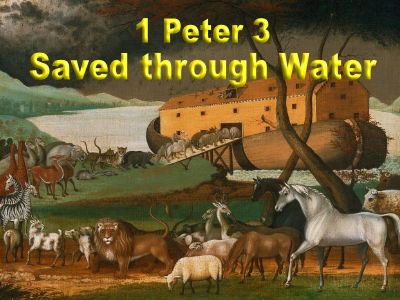
Here is our next scripture which speaks specifically about baptism using that word and even references water as integral in the process. It’s 1 Peter 3:18 and following.
1 Peter 3:18-22
For Christ died for sins once for all, the righteous for the unrighteous, to bring you to God. He was put to death in the body but made alive by the Spirit, through whom also he went and preached to the spirits in prison who disobeyed long ago when God waited patiently in the days of Noah while the ark was being built. In it only a few people, eight in all, were saved through water, and this water symbolizes baptism that now saves you also–not the removal of dirt from the body but the pledge of a good conscience toward God. It saves you by the resurrection of Jesus Christ, who has gone into heaven and is at God’s right hand–with angels, authorities and powers in submission to him.
Let’s start with the Gospel Message!
When Peter begins teaching us about water baptism, he begins in a really great place. He begins by reminding us about the Gospel. Christ died for sins, once for all, the righteous or the unrighteous to bring us to God. That’s awesome. He leaves no doubt in our minds regarding Jesus sacrifice for us and he does it in a succinct and thorough manner. He’s almost poetic and lyrical in his presentation of the Gospel!
Next, he says something curious. He tells us Christ was made alive by the Spirit and it is through this Spirit he goes and preaches to “the spirits in prison.” Which spirits are those? They are the spirits “who disobeyed long ago when God waited patiently in the days of Noah while the ark was being built.”
Wow, that would have been a very long time ago! We don’t know exactly who these spirits were and there is tons of speculation we might offer but when we think of the who, what, when, where, how and why, we have most of it locked down. We just don’t know specifically why Jesus went and preached. Now, regarding these spirits there is one thing we know for sure… we do know they had been disobedient! Also, with certainty, we know their time in history. They were from a time during the construction of Noah’s Ark.
Then suddenly, Noah’s Ark becomes the central figure in Peter’s lesson. He goes on to explain… “In it, only a few people, eight in all, were saved through water.”
In it… what? Well, the Ark. That’s what “in it” refers to. Peter reminds us that only a few people were saved. He even tells us specifically how many. Only eight people were saved. Who were these people?
Genesis 7:13
On that very day Noah and his sons, Shem, Ham and Japheth, together with his wife and the wives of his three sons, entered the ark.
The Ark Plus Water Equals Salvation
So, just Noah’s family. Only eight people out of all the people in the entire world were saved? How were they saved? Peter says, “through water!”
This little statement opens a floodgate of discussion. How were these people saved “through water?” It was because of the water, the Ark floated. When the people got into the Ark, their salvation was assured. All those who did not get “into” the Ark were destroyed. Where have we heard this type of language before? How about Galatians 3 where we are taught that we get “into Christ” during our baptism? We get “into” Christ, who saves us, just like Noah and his family got into the Ark which saved them.
The Ark floated on the water and the people were saved. They were saved by the Ark but they were also saved because of the water. If God had decided to destroyed the world of that day with fire, the Ark would have been of absolutely no value. But, since this is a flood, The Ark and the water worked together to secure the salvation of Noah’s family. Without the water… no salvation.
The Flood is a Symbol of Baptism
Next, Peter makes an amazing statement, he says, “and this water symbolizes baptism.” Now, we gotta stop right here. We need to ask an important question. Which water is Peter referencing? Well, the water he has just been talking about, the water of the flood. Up until now, he has said nothing about baptism, so it would not be reasonable for anyone reading his letter to think he was taking about baptism. So far, he has only spoken about The Flood.
It is only after his identification of this specific water (The Flood) that he links it to baptism. This is important because sometimes folks get confused as to what the symbol is in this passage. Is the symbol the flood or is the symbol baptism. Listen again carefully to Peter’s statement. He tell us exactly what the symbol is. “…and this water symbolizes baptism.” Once again, which water symbolizes baptism? The water of Noah’s flood. The water that floated the Ark. Baptism is not a symbol of anything here.
The Flood is a symbol of baptism. Linguists call this an “archetype.” An archetype is a pattern that precedes something which comes later. It is also referred to as a foreshadowing… a shadow that appears well in advance of the real deal.
Foreshadowing, It’s all over the Old Testament!
The concept of foreshadowing is massive in the Old Testament. It is a technique God seems to delight in as He drops clues all over the place pointing to when and where the Messiah would appear and how it would all happen. Take the entire concept of the Passover Lamb. This is a foreshadowing of Jesus being the sacrifice for sins and God’s wrath “passing over” those who have been crucified with Christ. You can probably think of a good many other examples of foreshadowing in the Old Testament.
Back to Peter…. “and this water symbolizes baptism that now saves you also…”
So, the water of the flood is a foreshadow of baptism and it saves you! What saves you? The water of the flood? Of course not. The flood is ancient history. Peter must be talking about something available, here, now and for everyone who hears his words. He is obviously talking about the water of baptism. In this context, we discover the controversial statement, “it saves you.”
Folks, we can’t get around this statement. Peter says, “It saves you,” referring to water baptism. Baptism must have something to do with salvation. Fortunately, he gives us some more details.
“…not the removal of dirt from the body but the pledge of a good conscience toward God. It saves you by the resurrection of Jesus Christ.”
Baptism in and of itself saves nobody. We know from all of our previous studies that water baptism is just the final step of faith a person takes who has experienced the other four steps in the Biblical Plan of Salvation. Baptism is an act of faith; faith in Christ. Peter compares two things, the removal of dirt from the body and the pledge of a good conscience toward God. One is physical and external, one is spiritual and internal. What is the common link between these two things? Both deal with cleaning something. Physical washing cleans the body but the vow of a clean conscience is required before God cleans our soul. One is effective, one is not.
Baptism is the pledge to keep yourself pure.
In baptism, we are making a pledge that we will keep a clear conscience for the rest our our life. We are recognizing before God, and before men, that God is about to forgive us all our sins and we are making a solemn vow to keep our hearts and minds holy, pure and clean. Removing dirt from the body is of no concern and that is not what baptism is about. It is however about keeping our conscience clean, once the filth of sin is removed by God.
Now, consider this carefully. Do you think God wipes away our sin before we make our pledge to him to keep ourselves pure? I don’t. I think baptism is our pledge… our dedication; the final step. Until there is an acceptance of the covenant, we are not entitled to its benefits. They do not belong to us. When we are baptized, we put our seal on the deal, so to speak, we die to our old life and the sin is wiped away by God. Then and only then do we become part of the Kingdom with all of its rights and privileges. Baptism is how we sign the contract!
Peter goes on… “It saves you by the resurrection of Jesus Christ.”
Baptism Saves You?
There’s that phrase again, “it saves you.” This is now the second time Peter has used it. What does “it” refer to? The only thing it can refer to, baptism. Baptism does not save you by something magical in the water. It saves you by the resurrection of Jesus Christ. Just like in the passages of Galatians and Romans we have looked at. We see that baptism is a participation in the death burial and resurrection of Christ and it is by the power of His resurrection which confirms that we too will be resurrected. This is amazing in its logical flow. In order to know about baptism, someone must have told us about it. Think about the Ethiopian Eunuch or Saul of Tarsus. In both cases, baptism is a response to everything they had heard. Baptism is not an outward sign of an inward grace. It is our faith in action as we deny our pride and die in the flood.
Pro-baptism proponents often shoot themselves in the foot because they use this statement “it saves you,” as their main claim that water baptism is necessary for salvation. They get themselves into a bind because they focus so much on this one point that their critics accuse them of being “water salvationists.” They come across as teaching that salvation is all about baptism when they dogmatically claim, “You must be baptized to be saved.”
Now frankly, that is what Peter just said, but when we forget everything that comes before baptism we haven’t even got the proverbial baby into the bath-water before our opponents toss it all out.
This is why I so desperately want to rid the world these tired old arguments about baptism. The argument is whether or not we are going to have A Faith that Obeys. The argument is about obedience not baptism. Baptism just happens to be one of the many things God tells us we must believe, accept and obey before we can begin our relationship with him.
Read the scriptures. Think about it. We never see the Holy Spirit given to a person who has not obeyed the Gospel. We never see the forgiveness of sins bestowed on an individual who has not obeyed the Gospel. We never see the Gift of Eternal Life given to an individual who has not obeyed the Gospel. Over and over and over again, in a variety of ways with consistency and clarity, throughout all of scripture, the Bible teaches, “obedience is required for salvation.” Baptism is a simple, clear Biblical command which must be obeyed if we truly love the Lord.
Peter was quite comfortable telling people, “Baptism saves you.” We need to get comfortable with that statement too.
Two final thoughts…
Now, a couple of final thoughts on Peter’s presentation.
Remember how Peter taught us that it was through The Flood that people were saved? Remember how we discussed that it was the Ark and the Flood working together which saved those people? Well, there are two other aspects of all this I think people miss. Without question, the Food of Noah is a foreshadowing of baptism. Because of that flood and the people’s obedience to God’s command to get into the Ark, they are saved. But isn’t it curious that Peter also introduces a group of people who had been disobedient? Why would he do that if he was leading up to an instruction about baptism? What do these disobedient souls of Noah’s day have to do with baptism? Because baptism is an act of obedience to God’s word. Peter is making a distinction between people who obeyed and people who did not! Without the same kind of obedience as Noah and his family, there will be no salvation.
Now, there is one final fascinating point in this whole discussion which I think gets really overlooked. Exactly what did this flood, which symbolizes baptism, do? What was the effect on the world?
Check this out. The Flood wiped away sin! It wiped away the sin of the entire world!
This is huge! The Flood is a foreshadowing of baptism. And everything the flood did, baptism does today because of Christ’s sacrifice on the cross and our willingness to obey.
So, just as in Noah’s day, the only people who will be saved are the folks who have A Faith that Obeys!
Enjoy!Dana Haynes

